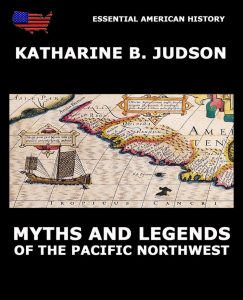Myths And Legends Of The Pacific Northwest – Katherine Berry Judson
Miss Judson has collected these myths and legends from many printed sources. She disclaims originality, but she has rendered a service that will be appreciated by the many who have sought in vain for legends of the Indians. There is an agreeable surprise in store for any lover of folk-lore who will read this book.

Myths And Legends Of The Pacific Northwest
Format: Paperback.
Myths And Legends Of The Pacific Northwest.
ISBN: 9783849675356.
Available at amazon.com and other venues.
Basics on the Pacific Northwest (from wikipedia.com)
The Pacific Northwest (PNW), sometimes referred to as Cascadia, is a geographic region in western North America bounded by the Pacific Ocean to the west and (loosely) by the Cascade Mountain Range on the east. Though no agreed boundary exists, a common conception includes the U.S. states of Oregon and Washington and the Canadian province of British Columbia. Broader conceptions reach north into Southeast Alaska and Yukon, south into northern California and east to the Continental Divide, thus including Idaho, Western Montana, and western Wyoming. Narrower conceptions may be limited to the northwestern US or to the coastal areas west of the Cascade and Coast mountains. The variety of definitions can be attributed to partially overlapping commonalities of the region’s history, culture, geography, society, and other factors.
The Northwest Coast is the coastal region of the Pacific Northwest and the Northwest Plateau (also commonly known as “the Interior” in British Columbia and the Inland Empire in the United States) is the inland region. The term “Pacific Northwest” should not be confused with the Northwest Territory (also known as the Great Northwest, a historical term in the United States) or the Northwest Territories of Canada.
The region’s largest metropolitan areas are Greater Seattle, Washington, with 3.7 million people, Greater Portland, Oregon, with 2.4 million people and Greater Vancouver, British Columbia, with 2.4 million people.
A key aspect of the Pacific Northwest is the US–Canada international border, which the United States and the United Kingdom established at a time when the region’s inhabitants were composed mostly of indigenous peoples. The border — in two sections, along the 49th parallel south of British Columbia and the Alaska Panhandle west of northern British Columbia — has had a powerful effect on the region. According to Canadian historian Ken Coates, the border has not merely influenced the Pacific Northwest—rather, “the region’s history and character have been determined by the boundary.”
(The text of the last section was taken from a Wikipedia entry and is available under the the Creative Commons Attribution-ShareAlike License.)
Publisher’s Note: This book is printed and distributed by Createspace a DBA of On-Demand Publishing LLC and is typically not available anywhere else than in stores owned and operated by Amazon or Createspace.
